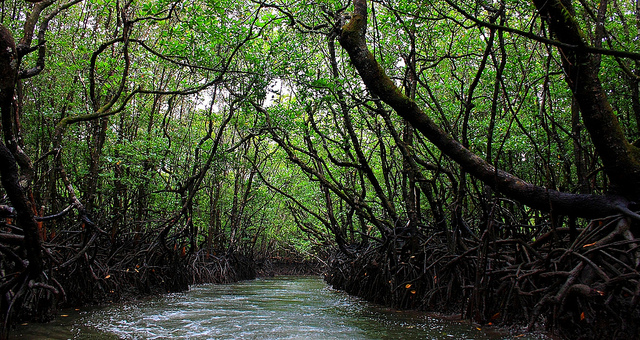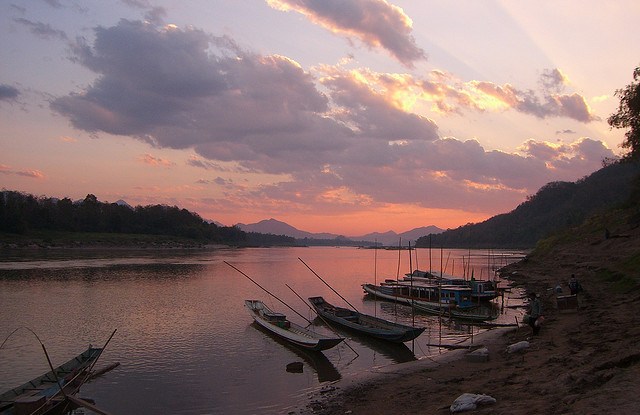
Much is made about the loss of such “charismatic” ecosystems as tropical rain forests and coral reefs. Far less is said about coastal wetlands, including mangrove forests, which are being lost due to development, agriculture and aquaculture.
In recent years, a growing policy effort is seeking to protect these threatened habitats through payment for ecosystem services (PES) schemes—but the nature of coastal wetlands, and the threats they face, raises challenges for the viability of PES schemes.
Coastal and marine ecosystems provide a range of valuable ecosystem services, ranging from fisheries and coastal protection, to carbon stocks that are important for mitigating climate change. Coastal mangrove forests can contain much more carbon per unit area than their terrestrial counterparts: This coastal “blue” carbon has been deposited on every tide over thousands of years and is stored in deep peat soils. Destruction of blue carbon habitats globally could release more than 1 billion metric tons of carbon dioxide annually.
Payments for blue carbon services are beginning to feature prominently on the international agenda, under programs such as the International Blue Carbon Initiative, coordinated by the International Union for Conservation of Nature, UNESCO and Conservation International. Local schemes have also emerged, such as Mikoko Pamoja, a 107-hectare mangrove conservation project in Kenya. PES schemes and proposals are also emerging to protect a range of other coastal and marine ecosystems for services associated with fisheries, marine biodiversity and coastal protection.
Yet PES schemes have been designed principally for terrestrial systems, and it remains uncertain how they will function in coastal and marine ecosystems with fundamentally different biophysical features. Notably, the long-term viability of these projects may be deeply impacted by events that occur outside the site, such as changes in sediment supply, hurricanes and sea-level rise. Our recent paper in Global Environmental Change defines these external stressors, and discusses their implications for PES.
In this post, we argue that the unique biophysical attributes of coastal and marine systems may be particularly vulnerable to risks associated with external stressors.
DIVERSE STRESSORS
External stressors come in a variety of forms, which we categorize along three main axes.
Firstly, external stressors may be point-source (such as a sewage outflow) or diffuse (such as agricultural pollution originating from farms along a river catchment that discharges to the coast).
Secondly, external stressors differ in their spatial scale, from the local (e.g. oil spill), to the catchment (e.g. agricultural pollution), to the regional scale (e.g. ocean acidification).
Thirdly, external stressors differ in how their impact is felt over time. Some stressors such as a pest infestation can yield immediate impacts, while other stressors, especially those related to global climate change, can be severe but gradual.
A leading example of an external stressor in coastal and marine landscapes involves changes in sediment inputs. Proposed dam construction along the Mekong River, for example, could reduce terrestrial sediment input into the local coastal zone by a maximum of 96 percent. These sediments help build surface elevations that enable coastal mangroves to keep pace with sea-level rise. Where these mangroves experience sediment deficits, sea-level rise could effectively “drown” these forests over time, compromising biodiversity, blue carbon and other important ecosystem services.
Understanding how these stressors impact ecosystems can be challenging, particularly because stressors can also have additive and potentially synergistic interactions. For example, a diffuse stressor such as heavy-metal pollution may stress mangrove vegetation to the point where it becomes more susceptible to other stressors, such as fungal infection.
IMPLICATIONS FOR PES DESIGN
PES schemes must contend with these realities. This presents challenges that are greatest in highly interconnected coastal and marine systems—landscapes in which upstream and across-stream stressors can profoundly impact neighboring ecosystems.
External stressors can make it difficult to define the parameters of target ecosystem services: While an emerging blue carbon PES scheme might successfully protect a mangrove from deforestation, it may have little influence on changes in upstream sediment loads or on sea-level rise. This would require changed PES scope and scale, as well as the demands of tracking external stressors, including measurement of changing sediment loads and accretion, and sea-level rise modeling.
External stressors can also make it challenging to identify ecosystem service providers and beneficiaries in a PES scheme. If the drivers of ecosystem loss are external to the site targeted by a PES scheme, this raises questions about who is the actual provider of the service.
External stressors also introduce further risks for scheme participants. If actors trade in ecosystem services (such as blue carbon or biodiversity) degraded by external stressors that are beyond their control, this introduces questions about responsibility and liability.
POLICY RESPONSES
Making PES work for marine and coastal systems requires a three-pronged approach to contend with external stressors.
Firstly, we must evaluate potential blue carbon sites for their exposure to external stressors by undertaking impact assessments of activities occurring in the landscape surrounding a potential site. Modeling exercises can also evaluate potential stressor impacts and ecosystem service provision, though may not be feasible in many locations due to lack of data, resources or expertise.
Secondly, once identified, it may be possible to mitigate certain external stressors through cross-sectoral planning, or specific mitigation actions aimed at single stressors.
Finally, it may be possible to accommodate some of the risks associated with external stressors through financial risk management mechanisms. This may take the form of third-party ecosystem service insurance, as has been suggested for mangroves by Australian legal experts, or credit buffers and precautionary savings, as has been implemented for some terrestrial PES schemes. These mechanisms can help insulate participants, including vulnerable smallholder participants, to financial shocks.
Importantly, the diversity of coastal external stressors means that we need to begin planning PES schemes within a framework that integrates evaluation, mitigation and accommodation instruments together, as opposed to the individual use of such instruments. We must also be willing to admit that coastal and marine PES may not work in all contexts, particularly not for sites and ecosystem services that experience complex, interacting and diffuse external stressors that can transcend sectors and political boundaries.
The recognition of, and planning for, coastal and marine external stressors will better enable us to improve the livelihoods of coastal populations while protecting imperiled coastal ecosystems.
Jacob Phelps is a Scientist at the Center for International Forestry Research (CIFOR). Dan Friess is an Assistant Professor in the Department of Geography, National University of Singapore.
For more information on ecosystem services, please contact j.phelps@cgiar.org or dan.friess@nus.edu.sg
We want you to share Forests News content, which is licensed under Creative Commons Attribution-NonCommercial-ShareAlike 4.0 International (CC BY-NC-SA 4.0). This means you are free to redistribute our material for non-commercial purposes. All we ask is that you give Forests News appropriate credit and link to the original Forests News content, indicate if changes were made, and distribute your contributions under the same Creative Commons license. You must notify Forests News if you repost, reprint or reuse our materials by contacting forestsnews@cifor-icraf.org.

